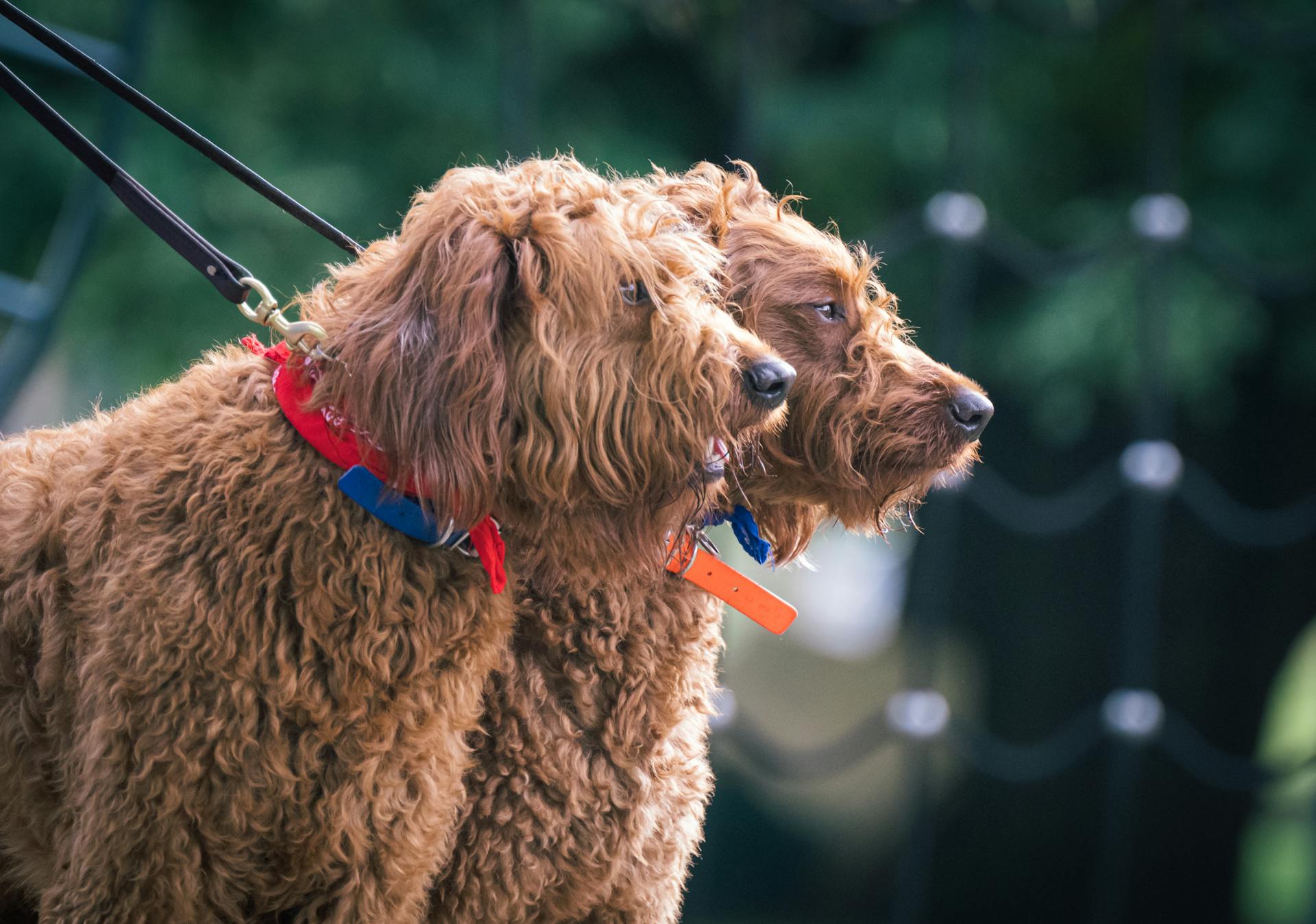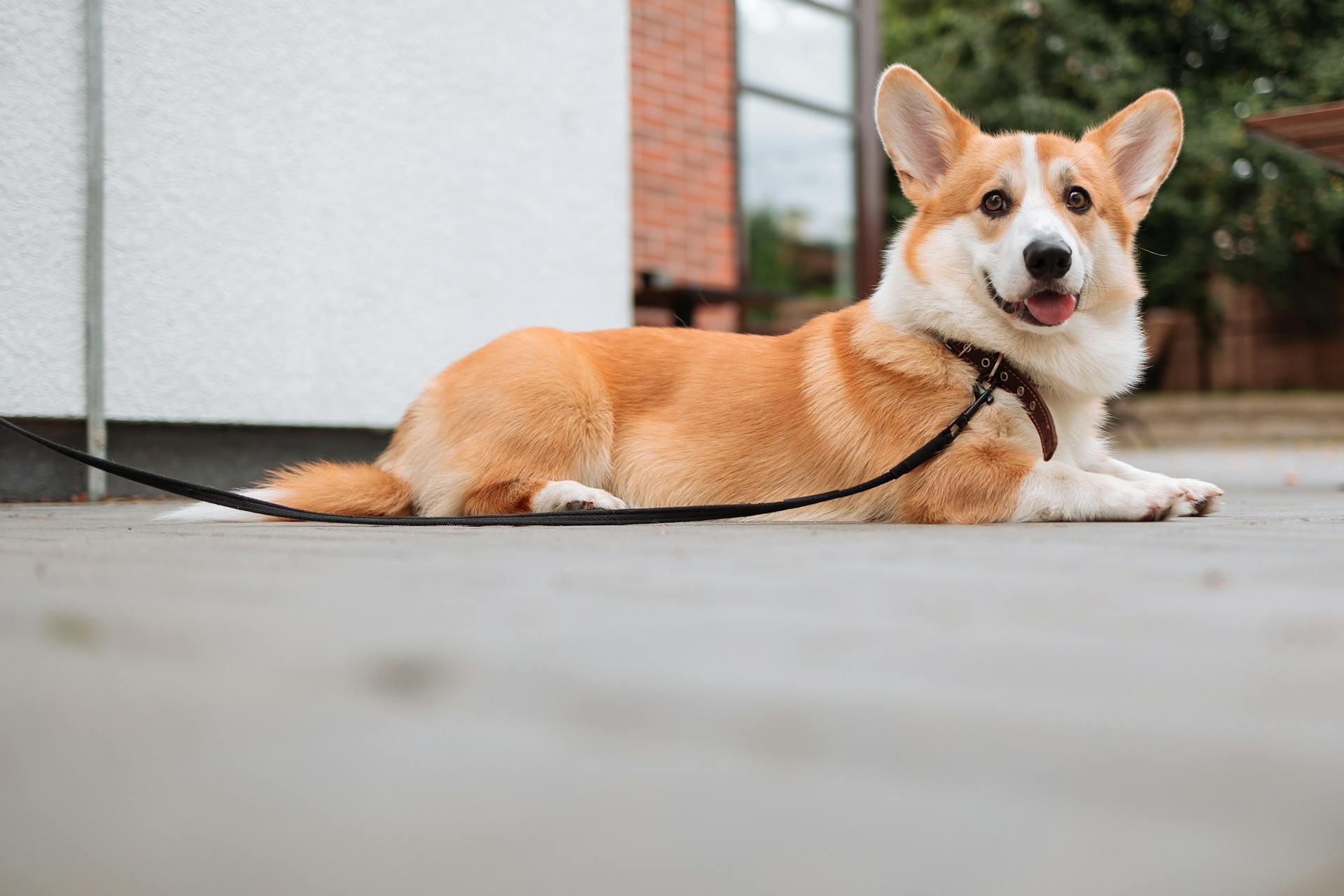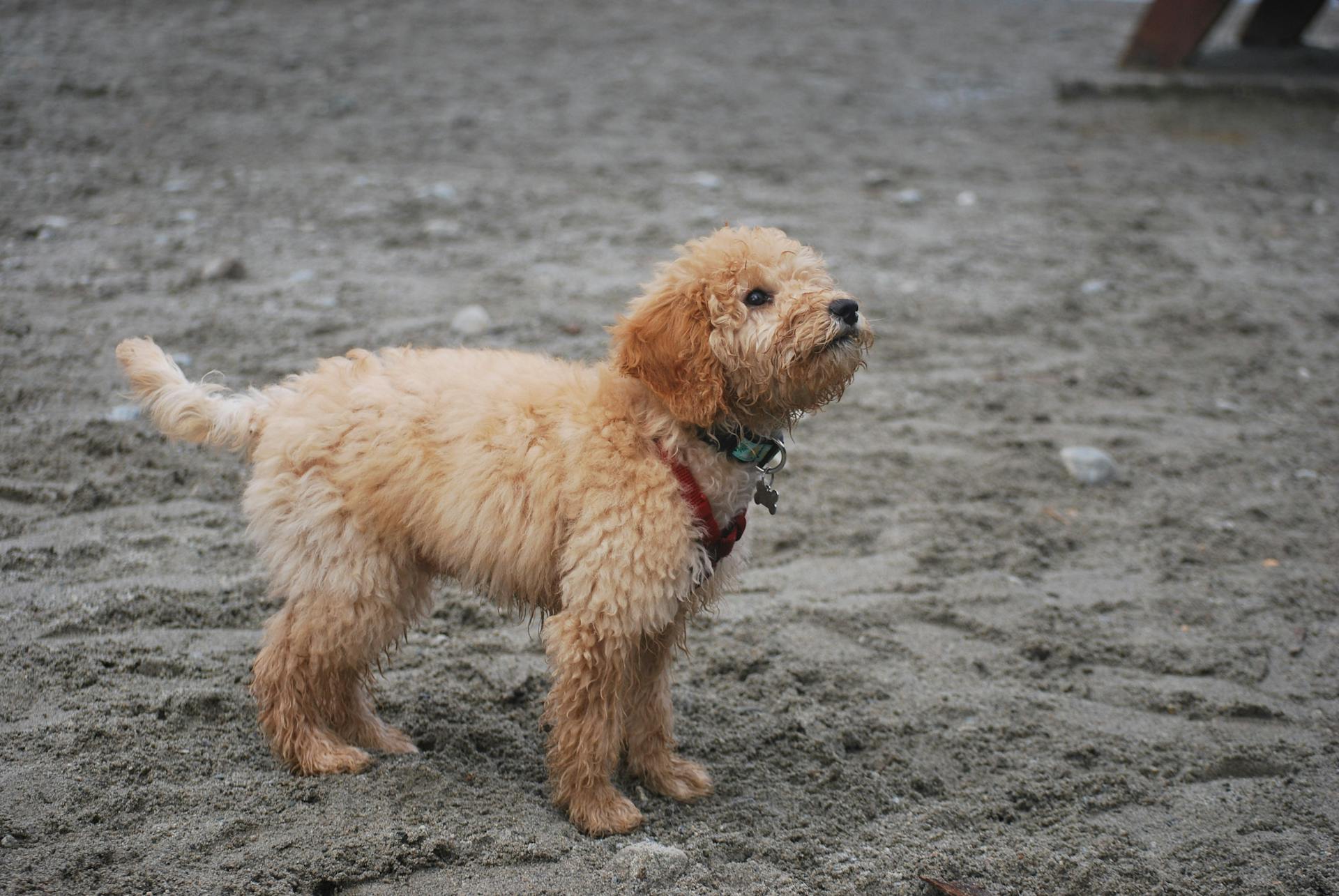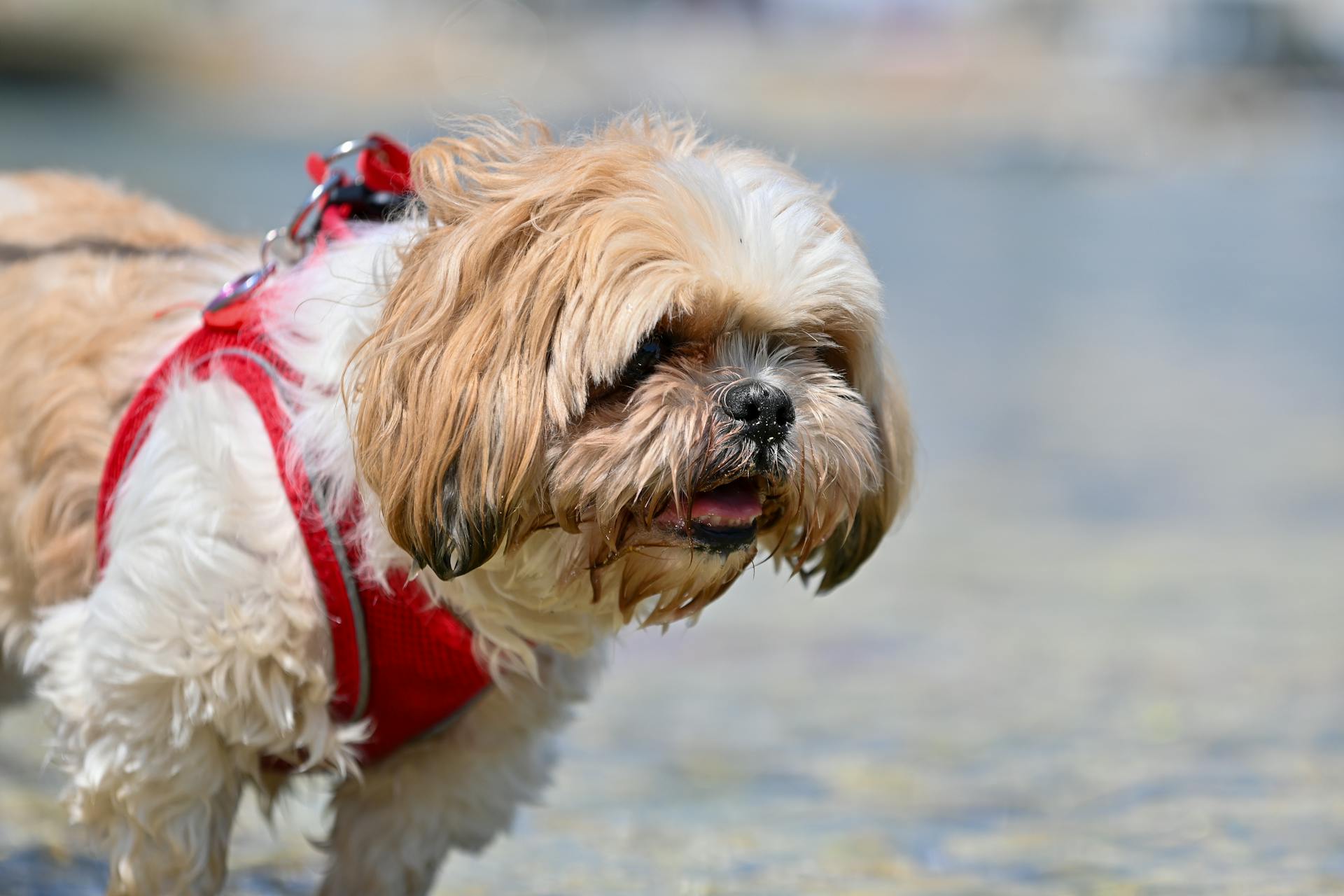
Shih Tzus are a popular breed known for their friendly and outgoing personalities. They originated in Tibet and were bred as palace dogs for Chinese emperors.
Shih Tzus are small dogs, weighing between 9-16 pounds and standing about 8-11 inches tall. Their long, flowing coats require regular grooming to prevent matting.
Shih Tzus are generally good with children, but they can be wary of strangers and may require time to warm up to new people.
Appearance
The Shih Tzu is a sturdy toy breed that weighs between 9-16 pounds, with a long, silky, luxurious double coat that comes in 14 different colors. This coat requires regular grooming to prevent it from hanging in front of their eyes.
A small white spot on their forehead, known as the "Star of Buddha", is a highly prized feature of the Shih Tzu breed. This marking is often considered a distinguishing characteristic of the breed.
Shih Tzus have a unique smile due to their undershot bite, where the lower jaw is just wider than the upper jaw. This means that their upper teeth bite inside the lower teeth when their mouth is closed.
The Shih Tzu's hair grows in every direction, including up from their snout, which requires frequent grooming to keep it under control. To keep their face hair from getting in the way, owners must regularly trim and style it.
Shih Tzus carry themselves with great pride, thanks to their royal heritage as companions to Chinese royalty. They often walk with their head held high and their tail curved over their back, giving the impression of being slightly arrogant in their gait.
Consider reading: Australian Silky Terrier Short Hair
Temperament
Shih Tzus are bred to be friendly companions, so they crave attention and affection from their owners. They're happiest when perched on your lap.
They may initially bark at new people, but they quickly make friends with everyone they meet. This is because they're bred to be outgoing and social.
Shih Tzus love being the center of attention, which makes them command attention wherever they go. Their gorgeous appearance and charming demeanor are hard to resist.
They're smart and athletic, even at their small size, and love to learn new things. However, it may take them some time to truly understand what's being taught.
Proper socialization is key for Shih Tzus, especially when it comes to new sights, sounds, people, dogs, and other animals. This helps them become confident and calm in new situations.
With proper introduction and socialization, Shih Tzus can get along great with children. They're sturdy and sweet-natured, making them a great match for families with kids.
Living Needs
Shih tzus are loving and charming with all family members, especially if trained properly and socialized.
They coexist peacefully with cats and other dogs, making them a great addition to multi-pet households.
As they were bred to spend time indoors, shih tzus are ideal for apartment dwellers or homes without a lot of outdoor space.
They're happy to bask in the breeze of a fan and appreciate air conditioning to stay cool.
However, their lavish coat and flat face make them susceptible to heat stroke, so it's essential to provide a cool place for them to rest.
Shih tzus aren't natural swimmers, so don't expect them to jump into the water to cool down.
They have a quirky habit of eating their own or other animals' feces, so it's crucial to watch them closely during walks or at the dog park and clean up their poop immediately.
Shih tzus love to be carried around, but it's essential to hold them securely as they tend to be front-heavy and may jump off furniture, which can lead to injuries.
Care
Shih tzus require regular grooming to prevent tangles and keep their coat looking its best. They need to be bathed weekly and brushed daily, with a wire brush being the best tool for the job.
Daily grooming sessions should include brushing and combing their hair in sections, starting from when they're a puppy to get them used to the process. This will make lifelong grooming easier for both you and your shih tzu.
Shih tzus shed very little, but their nails still need to be trimmed monthly and their ears checked for dirt and redness. This is a crucial part of their care to prevent infections and irritation.
If this caught your attention, see: Shih Tzu Trimmed
How to Care for a
Shih Tzus need to be bathed weekly and brushed daily to prevent tangles.
Their coat will change from fluffy to silky at about a year old, and some owners choose to get a shorter haircut to make grooming easier.
You'll need to trim their nails monthly and check their ears for dirt, redness, or odor.
Shih Tzus are prone to tear stains, so be sure to wipe their faces with warm water and a soft cloth.
They have short little legs and only require minimal exercise, such as a short daily walk or indoor playtime.
Consistent and patient training is key, especially with crate training, which can help when traveling.
Housebreaking can be challenging, taking up to 50 repetitions to get the routine right, so be prepared for patience and positive reinforcement.
Shih Tzus are low shedding and hypoallergenic, making them suitable for pet parents with allergies.
Their double-layered coat requires regular grooming to prevent matting and tangling.
A fresh viewpoint: Toy Dogs for Short
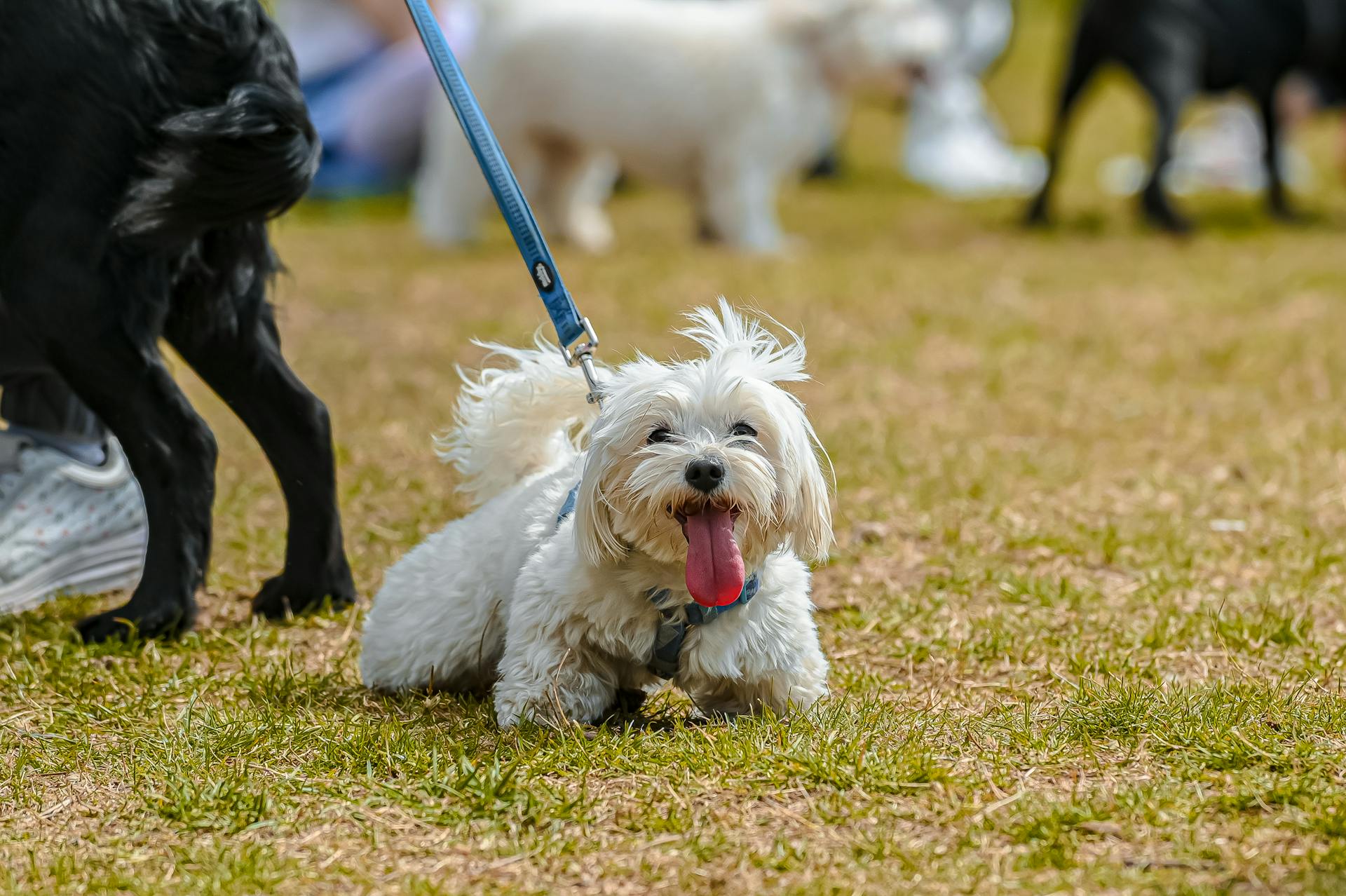
Daily brushing, especially of the top knot and beard hair, and regular bathing are essential for keeping their coat clean.
A pin comb, pin brush, or slicker brush is the best tool for the job.
Shih Tzus have a fast metabolism rate and need to be fed in small quantities in frequent intervals to avoid overeating.
Dog foods specifically designed for small-sized dogs are recommended, as they contain the right levels of essential nutrients.
House Training
House training your Shih Tzu puppy can be a breeze, especially since they're eager to please and learn. You can start house training as young as eight weeks old.
It's essential to establish a routine for regular voiding, as this helps your puppy learn to go potty at designated times. Take your Shih Tzu puppy out after meals, before bedtime, and immediately after napping or waking up.
Rewarding your puppy with treats and praises is key to effective potty training. Offer its favorite dog treat together with praise once it has peed or pooped in its potty area.
Keep an eye out for signs your pup needs to void, such as sitting by the door, sniffing, or making circles. Don't scold your puppy for accidents, as this can set back the training process.
Check this out: Training a Shih Tzu
Health
Shih Tzus are generally healthy dogs, but like any breed, they can be prone to certain health issues.
Their life expectancy is between 10 to 16 years.
Shih Tzus can deal with ear infections, hip dysplasia, patellar luxation, umbilical hernias, and a portosystemic liver shunt.
These issues are all treatable, so don't worry if your Shih Tzu develops any of them.
Their prominent eyes can give them trouble, including cataracts, progressive retinal atrophy, retinal detachment, and corneal dryness.
If you notice any issues with your Shih Tzu's eyes, reach out to your vet right away.
Shih Tzus may not lose their baby teeth before their permanent teeth come in, which may require a trip to the vet for extraction.
They can also have missing or misaligned teeth due to their undershot jaw.
As they get older, Shih Tzus may suffer from reverse sneezing, a wheezing sound made when they're overly excited, gulping their food too quickly, or have encountered an allergen.
Brachycephalic syndrome, a condition common in flat-faced breeds, can lead to breathing difficulties due to their shortened airways.
This can manifest as snoring, wheezing, or even more severe respiratory distress, particularly in hot or humid weather.
Regular eye examinations by a veterinarian are crucial to catch and manage ocular issues early.
Dental problems are another concern for Shih Tzus, as their small mouths can put them at higher risk of tooth overcrowding and be challenging to clean.
Regular dental care, including brushing and professional cleanings, can help prevent issues like dental decay and gum disease.
Shih Tzus are also prone to skin allergies, which can cause itching, redness, and hair loss.
Maintaining a healthy weight and providing regular, low-impact exercise can help reduce the risk of orthopedic problems like hip dysplasia and luxating patella.
Health Issues
Shih Tzus are generally a healthy breed, but like any breed, they can be prone to certain health issues.
Shih Tzus can be susceptible to ear infections, which are usually treated with antibiotics. Weekly ear cleaning is necessary to prevent recurrent ear infections.
Their floppy ears can trap bacteria, making them more prone to ear infections.
Shih Tzus are also at risk for eye disorders, such as keratitis and progressive retinal atrophy, which can lead to blindness if left untreated.
Regular eye examinations by a veterinarian are crucial to catch and manage these conditions early.
Their prominent eyes can also make them more susceptible to eye problems, including cataracts, retinal detachment, and corneal dryness.
Shih Tzus can be prone to dental problems, including tooth overcrowding and gum disease, due to their small mouths.
Regular dental care, including brushing and professional cleanings, can help prevent these issues.
They can also be prone to skin allergies, which can cause itching, redness, and hair loss.
Shih Tzus can be prone to orthopedic problems, such as hip dysplasia and luxating patella, which can be painful and debilitating if left untreated.
Maintaining a healthy weight and providing regular, low-impact exercise can help reduce the risk of these conditions.
Shih Tzus are also at risk for brachycephalic syndrome, a condition common in flat-faced breeds, which can lead to breathing difficulties.
This can manifest as snoring, wheezing, or even more severe respiratory distress, particularly in hot or humid weather.
Shih Tzus can be prone to obesity if overfed and/or under-exercised, which can exacerbate other health issues.
A balanced diet and regular exercise regimen are essential for keeping Shih Tzus happy and healthy throughout their lives.
Training
Training your Shih Tzu is a breeze because they're eager to please and learn quickly. You can start house training them as young as eight weeks old.
To ease the potty training process, start by offering training treats and praising your Shih Tzu when they do their business in the right spot. This positive reinforcement will help them associate good behavior with rewards.
It's essential to establish a schedule for regular voiding, taking your Shih Tzu out after meals, before bedtime, and after napping or waking up. Keep an eye out for signs they need to use the bathroom, like sitting by the door or sniffing around.
Here's a quick rundown of how often to take your Shih Tzu out:
Remember to be patient with your Shih Tzu during the training process, as it may take anywhere from 2 to 4 months for them to be fully potty trained.
Offer Training Treats
Offering training treats is a key part of effective potty training. Rewarding your Shih Tzu puppy with its favorite treat and praise after it has peed or pooped in its potty area can help reinforce good behavior.
You can use treats to encourage good habits, such as going to the bathroom outside and not making messes inside. This can be especially helpful when your puppy is still learning.
It's essential to have a stash of your puppy's favorite treats on hand to use during training sessions. This will make it easier to reward good behavior and keep your puppy motivated.
Offering treats after your puppy has gone to the bathroom can help establish a routine and make potty training easier.
You might like: Shih Tzu Behavior
Getting Started in Dog Sports
Getting started in dog sports can be an exciting and rewarding experience for you and your furry friend. To begin, it's essential to understand the basics of dog sports, which can be found in the "Intro to Dog Sports" section.
You'll find various dog sports to choose from, each with its unique characteristics and requirements. Consider enrolling your mixed-breed dog in a program, as many organizations welcome dogs of all breeds and backgrounds.
Titles and abbreviations can be confusing, but understanding what they mean will help you navigate the world of dog sports. Check out the "Titles & Abbreviations" section for a comprehensive guide.
If you're still unsure about which sport to try with your dog, take a look at the "Which Sport Should You Do With Your Dog?" section. This will help you determine the best fit based on your dog's age, breed, and energy level.
Before starting any dog sport, it's crucial to have a solid foundation in dog training. Head over to the "Get Started in Dog Training" section for tips and advice on how to get started.
If you're unable to attend in-person dog sports events, don't worry! Many organizations now offer virtual dog sports and events, which can be found in the "Virtual Dog Sports & Events" section.
General Information
Shih Tzus are small dogs who are often said to love life! They're part of the Toy Group in breed classification, and they take their noble origins seriously, loving to be pampered.
This breed boasts a gentle and affectionate temperament, making it a beloved family pet and an ideal companion for individuals of all ages. Shih Tzus are quite sturdy little dogs, despite their compact size.
They possess a spirited personality and a playful nature, delighting in interactive play and affectionate gestures.
Breed History
The Shih Tzu breed has a rich history that spans over 1,000 years, with records of "under the table" dogs appearing in China as early as 1000 B.C.
These early dogs were likely the ancestors of the Shih Tzu, and it's believed they were originally bred in Tibet by Tibetan monks. They were then sent to the Chinese emperors as gifts, where they were bred with Pekingese and pugs or Lhasa apsos to create the Shih Tzu we know today.
The breed gained even more status in 1861, thanks to Empress Dowager Cixi of China, who had a true love for animals and spent much time breeding them. She was gifted a pair of spectacular Shih Tzus by the Dalai Lama, who lived in their own palace and were trained to sit up and wave when the Empress arrived.
The breed was long hidden behind palace walls and only really introduced beyond Asia in the late 1920s and early 1930s, with a pair of Shih Tzus eventually finding their way to England in 1930.
A small number of dogs was used to rebuild the breed after it almost went extinct in the first half of the 20th century, and every Shih Tzu alive today can be traced back to one of these 14 dogs.
Unique Facts
The Shih Tzu is a unique breed with some fascinating characteristics. Their name, "shih-tzu kou" or "lion dog", comes from Chinese.
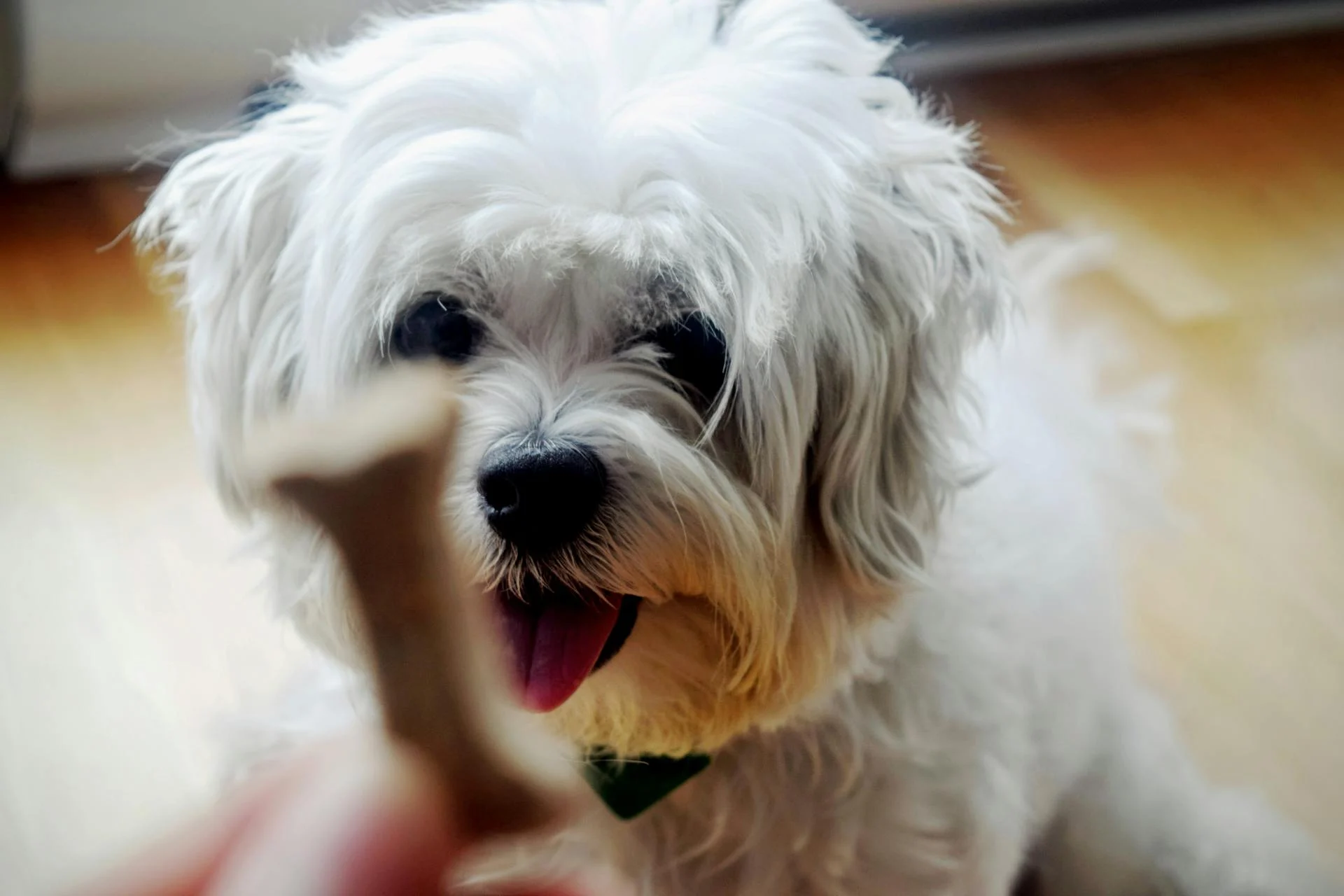
These dogs have hair that's more like human hair than the fur found in most canine breeds. Their luxurious coat is a result of this unique characteristic.
Shih Tzus got the nickname "Chrysanthemum-faced Dogs" due to the straight growth of their fur on the top and sides of their muzzle, resembling the flower.
They're brachycephalic, meaning they have a shortened muzzle or "flat-face." This can make breathing a bit more difficult for them.
The Shih Tzu shares more DNA with wolves than most other breeds, but not as much as the Nordic spitz group (Huskies, Samoyeds, and Malamutes).
Here's a rough breakdown of the Shih Tzu's weight range: 9-16 lbs (4-7.25 kg).
For another approach, see: Shih Tzu No Hair
Sources
- https://www.dailypaws.com/dogs-puppies/dog-breeds/shih-tzu
- https://www.oyen.my/post/the-101-guide-to-shih-tzus-personality-training-health-concerns
- https://www.trupanion.com/pet-blog/article/shih-tzu
- https://www.akc.org/expert-advice/lifestyle/fun-facts-shih-tzu/
- https://www.akc.org/dog-breeds/shih-tzu/
Featured Images: pexels.com
